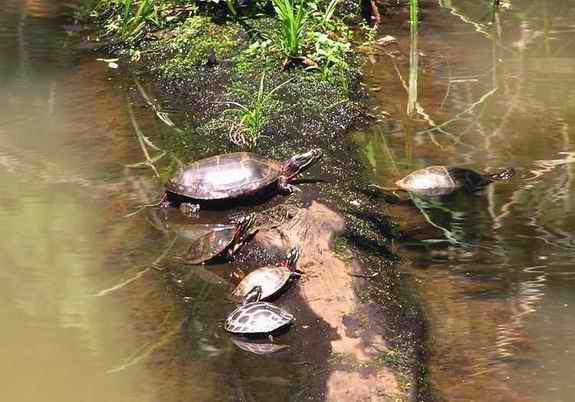|
Return to Hiker's Notebook Home Page
Common Name: Painted Turtle, Painted terrapin - The carapace (the upper, dorsal side of the shell) is highlighted by scutes (the individual horny plates of the carapace) that have light-colored seams; the head, tail and legs are striped with red and yellow markings. The overall effect of the combination is suggestive of an application of paint.
Scientific Name: Chrysemys picta - The generic name is a combination of the Greek words chrysos, meaning gold and emys, meaning aquatic turtle. The plastron (the lower, ventral side of the shell) and the stripes on the sides of the neck and head of the species are yellow, the primary color synonymous with gold. Picta is from pictus, the past participle of the Latin verb pingere, to paint. It is therefore scientifically classified as an aquatic turtle painted with gold.
The Painted Turtle is the most widely distributed turtle in North America, extending from southern Canada to northern Mexico and from coast to coast in the United States; it inhabits ponds, marshes and slow-moving streams that have soft, muddy bottoms. They are diurnal, generally spending the night on the muddy bottom and the day either searching for food or basking in the sun, sometimes in large groups stacked in layers. The heat of the sun helps to maintain a desired body temperature with the additional benefit of exterminating dermal parasites to which they would be otherwise subject.
The painted turtle is marginally dimorphic; the male has much longer front claws than the female and has a longer and thicker tail in which the cloacal (anal) opening is located at a greater distance from the body mass. Males are also generally smaller than females. The mating process occurs in the springtime and is generally characterized as graceful. The male slowly pursues, passes, and turns to confront the female. Courtship consists of the male using his longer front claws to gently caress the head of the female, who responds if receptive by using her foreclaws to rub those of the male. The pair subsequently sinks to the bottom of the pond to discretely mate.
Nesting occurs in early summer, the female seeking higher ground on the banks of the riparian habitat. At a distance from the water where the soil is moist and sandy, she digs a four to six inch deep flask-shaped nest, lays 5 to 10 eggs and covers them. On completing this, the most fundamental aspect of species propagation, the nest is abandoned. The hatchlings emerge about ten weeks later, dig their way out of the sand, and proceed to the safety of the water absent the benefit of parental nurture and guidance.
The sex of the hatchlings is determined by the temperature; relatively high incubation temperatures (87 degrees F, 30.5 degrees C) result in female turtles whereas low temperatures (below 77 degrees F, 25 degrees C) result in males. This phenomenon is known as temperature-dependent sex determination (TSD) and is common among reptiles. Lizards and crocodilians produce females at low temperatures and males at high temperatures, the opposite of turtles. There is no clear understanding of the rationale for TSD, though in the case of turtles, one might surmise that warmer conditions would be better for survival and females would be thus preferentially gestated to encourage more offspring. Similarly, colder conditions would presumably make survival more challenging and males would be favored with their larger front claws and concomitant mobility.
Research on the temperature dependence of sex in turtles has focused on observing the effects on natural populations of turtles and on understanding the mechanism by which the temperature determines the sex. In one study of 236 nests of turtles in Wisconsin, it was found that the nests were either all male or all female, with females predominating. The male to female ratio in turtles can be as low as one to twenty. Female nests were located in open sandy areas where sun exposure kept temperatures elevated; male nests were in vegetation where cool conditions prevailed. The onset of autumn also had a pronounced effect, as the sex ratio changed from nearly all females in August to all males in September. Research on the mechanism of TSD has revealed that each individual embryo has the ability to become male or female and that temperature triggers the genetic coding in the mid-trimester of development. The hypothesis is that the temperature modulates the production of steroidogenic enzymes in the vicinity of the genital ridge to cause the formation of either female estrogens or male androgens.
There are four subspecies of painted turtle. The eastern painted turtle (C. p. picta) is easily and uniquely identifiable since the scutes of the carapace are aligned so that the pattern is like graph paper. The midland painted turtle (C. p. marginata) has a dark blotch on the plastron but is otherwise not distinctive. The southern painted turtle (C. p. dorsalis) is the smallest variant; it has a conspicuous red stripe that runs the length of the carapace. The western painted turtle (C. p. bellii) is the largest variant, featuring a very fine net of lines on a green carapace. There is considerable interbreeding among the variants along their shared boundaries so that a mix of attributes is not uncommon. |
